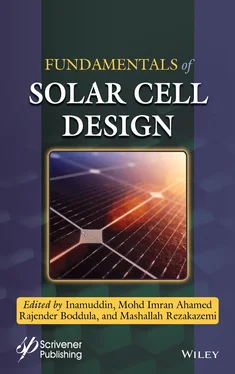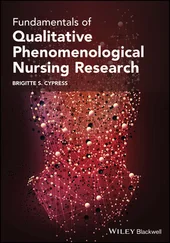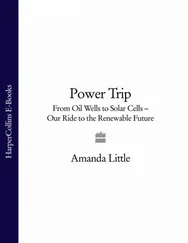The increasing population and its energy consumption are demanding huge energy and create the energy crisis. To fulfil the energy need, increase in power production using conventional resources produces the greenhouse gases which disrupt the climate change [1]. Currently, 80% of energy is prepared by non-renewable resources worldwide. The conversion of resources to energy generate massive CO2 emissions, which increases the temperature of the earth and melts the polar ice as result rise in sea level [2]. To understand the energy crisis and problem created by greenhouse gases, the scientist is taking much interest in alternative renewable energy sources.
The sunlight is the huge source of renewable energy and scientist is doing enormous research on photovoltaic (PV) technology. Today, scientist reaches up to third generation of solar cell, namely, tandem solar cell (TSC). The world-wide PV market has more than doubled in 2010, and the market nurtures again by almost 30% in 2011 [3].
Tandem cell construction presents a lane toward superior module efficiencies over single-junction design owing to the capability to divide the solar spectrum into multiple bands [4]. The simplest structure where two absorbers are stacked is the so called tandem. The stacked layer presents in tandem of different bandgap materials. When the sunlight falls on the tandem cell, the high energy light absorb by the material has high bandgap and the low energy light is secondly absorb with the lower bandgap [5].
In tandem devices, the intermediary layer is the critical processing steps, building an ohmic contact among the two sub-cells [6]. The TSC has two, three and four junction and efficiency reached upto 32.8%, 44.4%, and 46.0%, respectively. The multi junction device modelling evaluation is near approaches of the scientists. There are various types of TSC that can be differentiating on the basis of the material used in the cell. The organic tandem solar cell (OTSC) [7–12] is most suitable and economic but it has low efficiency upto 15%. The inorganic tandem solar cell (ITSC) [13–17] has very expensive and high efficiency upto 46% and used in space applications. The hybrid tandem solar cell (HTSC) [18–24] is the third type and Perovskite tandem has already proven to be quite efficient (17%) and low cost, mostly because of cheap materials that are being used.
3.2 Review of Organic Tandem Solar Cell
Ning Li et al. [3] developed single-junction OPV based on GEN-2:[60] PCBM achieve a PCE of 6.63%, and maximum PCE of 10% is expected for a TSC incorporating an OPV12:[60]PCBM-based at bottom and pDPP5T-2:[70]PCBM-based a top [25]. Abd. Rashid bin Mohd Yusoff et al. developed and characterized PSEHTT:ICBA and PSBTBT:PC70BM as the active layers and the TSC showed a high VOC 1.62V, a moderate JSC 8.23 mAcm 2, FF 62.98%, leading to the PCE of 8.40% [26]. Lingxian Meng et al. reported the performance of TSC on 0.05 to 1.12 sun intensities. The PCEs above 15% intensity varies within 4.97 to 112.68 mW/cm 2and PCE of 17.87% at intensity 25.99 mW/cm 2[27]. Muath Bani Salim et al. reported 26 single-cell OPV devices to form the TOPV front and back cells using PBDTS-TDZ:ITIC in the front cells and PTB7-Th:O6T-4F:PC71BM gives 18.6% efficiency [28]. Lijian Zuo et al . demonstrated two mirror-like electrodes, ultrathin Ag capped with a dielectric TeO2 layer, and a thick Ag electrode. As a result, a top-illuminated ITO-free SCTOPV show 7.4% and ITO-based 7.5% [29]. Abd. Rashid bin Mohd Yusoff et al . reported that Au-doped SLGNR electrodes are implemented in TSC, and PCE achieved is 8.48% comparable to generally used transparent electrode [30]. Hengda Sun et al. designed OHJ CGL that is composed of HAT-CN/m-MTDATA, which shows that MCE and EQE are achieved as 201cd/A and 54.5%, respectively ( Figure 3.1) [31].
Bangwu Luo et al. reported the use of PEDOT:PSS as the top transparent electrode in TSC. The fabricated CFPTSC with polymer electrodes displays PCE values from 7.23% to 8.34% and yielded color of the cells [32]. Miaomiao Li et al. reported a solution-processed TSC, based on DR3TSBDT and DPPEZnP-TBO, which propose proficient and shows the power conversion efficiency of 12.50% [33]. Thue T. Larsen-Olsen et al. reported opto-electronically probe individual junctions and carrier transport across interfaces in fully printed and coated TPSC. Inherent limitations to the accuracy of EQE and LBIC measurements on non-ideal TSC are described through the use of a small-signal electrical model Figures 3.2and 3.3[34].
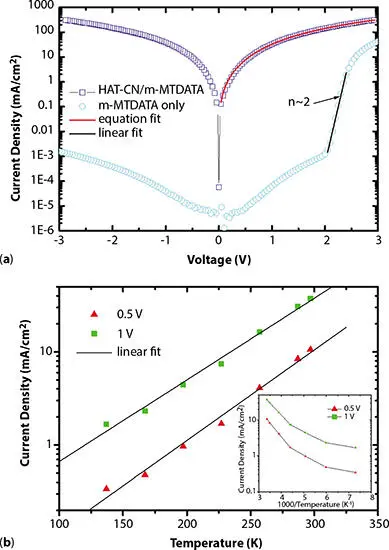
Figure 3.1 (a) J-V plot A and B. (b) Temperature-current density graph. (Reprinted with the permission from reference [31].)
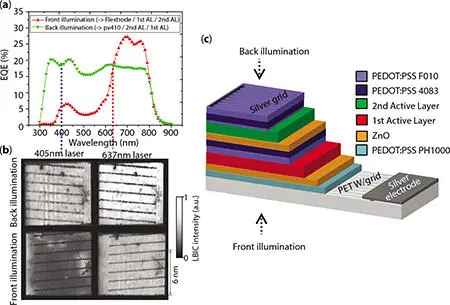
Figure 3.2 (a) Non-biased EQE spectra and (b) LBIC images using two different laser wavelengths. (c) Schematic structure tandem device. (Reprinted with the permission from reference [34].)

Figure 3.3 (a) LBIC with and without voltage and light biasing. The 405-nm LBIC probe laser and 660-nm bias. (b) Schematic structure of tandem PSC. (Reprinted with the permission from reference [34].)
3.3 Review of Inorganic Tandem Solar Cell
Z. Deng et al. developed the GaxIn1xP top sub-cell of a GaxIn1xP/GaAs double-junction TSC is exposed the EL image, 93 lm at forward bias of 2.75 V, which is 30 times more than unbiased GaxIn1xP single layer [35]. M. Elbar et al. reported PV double junction CGS/CIGS TSC, based on CGS and CIGS structures as top and bottom cells, respectively. The performance of single CGS and CIGS solar cells is with fixed thicknesses at 0.26 and 3.5 lm, respectively, and the PCE of 18.92% and 20.32% respectively [36]. Li Wang et al. fabricated GaAsP/SiGe TSC on Si, which shows 40% conversion efficiency ( Figure 3.4) and the three-terminal efficiency of 20.6% under 1× illumination [37].
Zekun Ren et al. investigated GaAs/GaAs/Si triple-junction structural design in which GaAs and Si form a non-ideal bandgap combination. GaAs/ GaAs/Si has attained 33.0% efficiency and harvested efficiencies between 31.4% and 32.1% [38]. Lukas Kranz et al. fabricated NIR-transparent PSC which enables PCE up to 12.1% but at CIGS enabled a device with 19.5% highest efficiency reported for a polycrystalline thin film [39]. Maoqing Yao et al. reported nanowire on-Si TSC on addition of the GaAs nanowire top and the Si bottom with a VOC of 0.956 V and an efficiency of 11.4% [40].
Zhe Liu et al. demonstrated the framework on the example of a 21.3% efficient stacked four-terminal GaAs/Si TSC. The short-circuit current density in the GaAs/Si TSC achieves 37.8 mA/cm 2with experimentally possible parameters [41]. R. Lachaume et al. reported that over 30% efficiency could be achieved for the tandem with only ~7 μm of epi-SiGe and ZnO/Ag back metallization. In the latter ideal scenario, the highest efficiency achievable is ~37% with 1.1-μm-thick Al0.15Ga0.85 as top cell and epi-Si0.73Ge0.27 as bottom cell less than ~30-μm thickness [42]. Shizhao Fan et al. reported 1.7 eV/1.1 eV GaAs0.75P0.25/Si TSC having efficiency of 20.0% and 16.5% efficient GaAs0.75P0.25 single-junction top cell on Si and a 7.78% efficient GaAs0.75P0.25 filtered Si bottom cell ( Figure 3.6) [43].
Читать дальше
